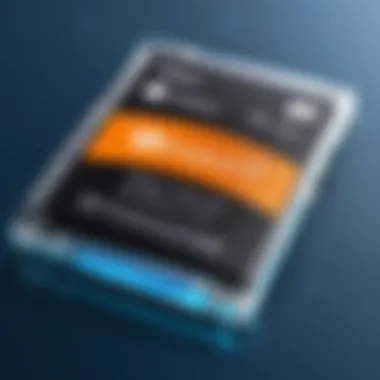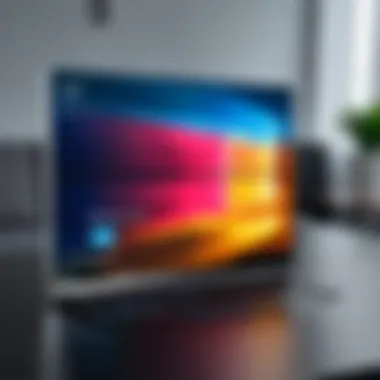Analyzing Windows 10 License Key Prices: A Comprehensive Guide


Intro
In the digital age, operating systems are essential for enhancing productivity and gaming experiences. Among these systems, Windows 10 serves as a prevalent choice. However, understanding the cost of Windows 10 license keys requires a nuanced approach. Various factors influence their prices, and equally important is the reliability of vendors offering these keys. This article delves into those dynamics, positioning readers to make informed choices.
Windows 10 offers different license types, such as Home and Pro editions. Their prices do not just depend on the edition but also on market trends and conditions. Moreover, potential buyers need awareness of the implications tied to purchasing from unfamiliar vendors. By examining a variety of aspects—from market landscape to price comparison—this guide aims to outline significant points for budgeting effectively for a Windows 10 license key.
Accurate budgeting is crucial whether for individuals, professionals, or gaming needs. Mere discounts do not always translate to the best value, and that's where in-depth understanding stands useful. Navigating the landscape of licensing allows informed decisions, potentially saving money while ensuring reliability and long-term satisfaction. Let's explore how you can approach this decision with confidence and knowledge.
Preface to Windows License Keys
Understanding Windows 10 license keys is critical for anyone looking to operate their system legally and efficiently. Software licensing can be complex, but getting it right is vital for maintaining the integrity of your operating system. A valid license not only unlocks full functionality of Windows but also ensures compliance with legal standards.
Definition of License Key
A license key is an alphanumeric code, usually composed of 25 characters, that authenticates your copy of the software. It serves to confirm that the software has been obtained legally and that its use is authorized. Microsoft issues these keys as part of their security measures to prevent piracy and unauthorized use.
Importance of a Valid License
Having a valid license is crucial for several reasons. First, a licensed version of Windows 10 enables all features and capabilities that are inherent to the software. Some functionalities, like updates and tech support, rely on a valid license. Without it, your experience may be limited, which can be particularly frustrating for those who rely on Windows for gaming or other demanding applications.
Moreover, using illegal or counterfeit license keys can result in substantial drawbacks. This includes unwanted security risks and possible legal penalties, creating a landscape where the initial savings could lead to much greater expenses. Ultimately, placing an emphasis on acquiring genuine licenses fosters a more secure and reliable technological experience.
"Investing in a legitimate Windows 10 license is essential for a safe and sober computing environment."
Types of Windows Licenses
Understanding the different types of Windows 10 licenses is crucial for consumers and tech enthusiasts alike. The type of license influences not just how the software can be used, but also aspects like support, transferability, and pricing. Each license serves a unique purpose and is designed for varying scenarios which makes it vital to comprehend their differences.
Retail License
A Retail License is the most flexible option out of the three common types. Users purchase it directly from sources like the Microsoft Store or authorized retailers. This license can be installed on multiple devices, though typically it can only be active on one device at a time. The key benefits of a Retail License include the ability to transfer the license to a new computer or device if the old one is no longer in use. This flexibility can represent significant long-term value, especially for users who frequently upgrade their technology.
"Retail licenses offer freedom to upgrade and re-establish systems without being tied to hardware."
Moreover, retail licenses come with updates and customer support, ensuring users always have the latest features and security updates available.
OEM License
An OEM License, or Original Equipment Manufacturer License, is less flexible compared to a Retail License. This type is typically bundled with a new computer or device. It is often cheaper because it is tied specifically to the original hardware it has been installed on. If the device fails, the OEM License usually dies with it; users cannot transfer the license to another machine.
Benefits of an OEM license largely include cost efficiency and pre-installed options that facilitate easy setup for the user. However, it should be noted that the level of support may vary. Most OEM licenses do not receive the same customer support as Retail Licenses do. Instead, the responsibility is shifted to the manufacturer of the computer.
Volume License
The Volume License option is tailored for businesses and organizations. This license allows for multiple activations, which is beneficial for larger scale deployments in corporate settings. Various tiers are available, accommodating the needs of small businesses up to enterprises. One significant advantage is the cost savings achieved by purchasing multiple license keys at once. Additionally, Volume Licenses often come with centralized support, making it easier for IT departments to manage their software environment.
Organizations often benefit from streamlined deployment and the ability to maintain control over licensing compliance without the repetitive task of individual installations. Volume Licenses can offer a more cyclical use arrangement, enabling updates and upgrades across many machines with ease.
Factors Influencing License Key Prices
Understanding the various components that play into the pricing of Windows 10 license keys is crucial for those planning to purchase or upgrade their operating system. The factors affecting license key prices can provide deeper insights into budget planning and expectations. Users need this knowledge to avoid common pitfalls and make informed choices.


Source of Purchase
The most significant influence on license key pricing is where the key is purchased. Generally, the primary sources include the Official Microsoft Store, authorized resellers, and third-party websites.
- Official Microsoft Store tends to have the highest prices due to brand assurance, direct support, and guaranteed authenticity.
- Authorized resellers can sometimes offer favorable discounts while maintaining product authentication. This channel is often regarded as a reliable compromise between cost and assurance.
- Third-party websites may tempt customers with notably lower prices. However, these keys can sometimes be from dubious sources, leading to potential legal and functional risks. Users need to be cautious when choosing this option, as it might save money now but could prove costly in the future.
This variation in sources highlights why careful consideration is needed when selecting where to buy a Windows 10 license.
Geographic Variations
Geographic location plays a significant role in license key pricing. The cost of a Windows 10 license can differ based on local market conditions and regional pricing strategies. Various factors contribute to this discrepancy, including:
- Demand and popularity: In territories where Windows 10 is more widely embraced, demand can drive prices upward.
- Economic factors: Currency exchange rates can impact pricing when comparing global costs. In some countries, users may find prices that differ drastically based on local economic situations.
- Regulatory differences: Variations in tax systems or government regulations around software sales can lead to price fluctuation. For example, some regions may impose high taxes on software, increasing the final cost the consumer sees.
Thus, understanding localized pricing strategies can save significant amounts during the buying process.
License Type Effect on Pricing
Different types of licenses influence Windows 10 key costs significantly. Familiarity with these types aids consumers in making suitable choices that align with their needs and budget.
- Retail Licenses generally have the highest price. They provide maximum rights to the consumer, allowing for transfer to new hardware and upgradability.
- OEM Licenses are often cheaper but have restrictions. These licenses are tied to the initial hardware and usually cannot be transferred to a new machine.
- Volume Licenses are tailored for businesses or educational institutions wanting multiple copies. They tend to offer reduced pricing dependent on the quantity purchased but require complex arrangements.
Acknowledging which license type aligns with intended use can guide consumers towards the right choice economically, enhancing their purchase experience.
Understanding pricing factors enhances customer empowerment, aiding in sound financial decisions that fit individual needs and situational demands.
Comparing Prices: Where to Buy
When it comes to acquiring a Windows 10 license key, knowing where to purchase can severely influence the price you pay. Each type of vendor presents unique benefits and considerations, which can affect both your initial cost and long-term experience with the software. Comparing prices not only provides clarity about pricing structures but also guides buyers toward making an informed choice that attends to their needs. Understanding the distinctions among different sources can help avoid unpleasant surprises and ensure a smooth installation process.
Official Microsoft Store
The Official Microsoft Store is perhaps the most direct source for obtaining a Windows 10 license key. Buying directly from Microsoft assures you of an authentic product every time. The prices listed on their website generally reflect the retail value without significant markups.
Advantages:
- Reliability of source
- Access to the latest updates
- Post-purchase customer support
Purchasing through the Official Microsoft Store eliminates concerns regarding legality and authenticity. The site offers options for both Home and Pro versions, allowing flexibility depending on your specific users cases. Despite being often the higher priced option, the assurance of quality might outweigh the extra cost.
Authorized Resellers
Authorized Resellers like Amazon and Best Buy can occasionally offer Windows 10 keys at lower prices compared to the Official Microsoft Store. These vendors have agreements with Microsoft, meaning they are permitted to sell authentic keys.
Characteristics:
- Price variability depending on promotions
- Midnight launches of new Microsoft products
- Chance to find bundle deals (like hardware/software combinations)
While it's generally safe to buy from these sources, it’s still crucial to ensure that the seller is indeed authorized. Authenticity check is simple—just visit Microsoft's list of authorized partners when in doubt. Look also for customer reviews and seller ratings.
Third-party Websites


Third-party websites can provide some of the most competitive pricing for Windows 10 license keys, but they come with higher risks compared to official and authorized platforms. Prices here can be significantly lower due to various factors, such as clearance sales or license reselling practices.
Considerations:
- Potential for fake or used keys
- Varied customer service experience
- Reliability of the site requires research
While platforms may promote cheap prices, due diligence is key. Check forums, such as Reddit, for user experiences with those websites. Understand that if any issues arise with activation, consumer protection may be limited.
In summary, every buying source for a Windows 10 license key has distinct benefits depending on price willingness, trust level, and support needed. Research and careful consideration will lead to secure and satisfactory purchasing.
Common Myths and Misconceptions
Understanding common myths and misconceptions about Windows 10 license keys is critical for anyone looking to make informed decisions. Many people believe certain narratives regarding prices and legal criteria for these licenses, which can lead to a range of issues, ranging from financial waste to serious legal trouble. By elucidating these myths, readers will be better equipped to navigate the complexities of acquiring a valid license.
Free License Keys
One prevalent myth posits that free license keys are a viable option for accessing Windows 10. In reality, while there are some forums and unofficial sites where individuals claim to provide such means, there are significant pitfalls to consider. First, many of these free keys are often pirated versions. Using them leaves users vulnerable to severe repercussions, including potential legal actions from Microsoft.
Another factor is related to reliability. Free keys frequently lead to unstable system performances. Often, they are tied to accounts that Microsoft can deactivate at any moment, rendering your system unusable. Instead of going down this risky path, it's advisable to invest in a legitimate license key to guarantee both functionality and security.
Permanent Licenses vs.
Temp Trials
The differences between permanent licenses and temporary trials are often underestimated. Temporary trials provide functionality for a limited period. Generally, this type allows users to experience all features of Windows 10, but functioning ceases once the period expires. Users then either have to activate a genuine license or remain without adequate access to banking applications and essential security updates.
On the other hand, permanent licenses offer more stability and assurance. Owning a permanent license means continued access without the pressure of an impending deadline. Furthermore, it guarantees software updates, essential for protecting your system from vulnerabilities or bugs encountered in everyday usage, particularly within enterprise environments.
In essence, users should be cautious and fully aware of what they are committing to before choosing between free keys or temporary licenses. They should rather prioritize legitimate channels that elevate both their legal standing and system performance.
The Impact of Using Illegal Keys
Using illegal keys for Windows 10 opens a multitude of challenges, both for the average user and with broader implications. It is crucial to emphasize that while these keys may appear to offer an easy or cost-effective solution, the ramifications often offset any perceived benefits. The topic dives into the understaning the legal penalties and security risks associated with such actions, illuminating why following legitimate licensing processes remains essential.
Legal Penalties
Using illegal license keys is not without significant legal risks. Microsoft has been clear in its stance against piracy. Users caught employing unauthorized keys may face fines, lawsuits, or restrictions imposed by the company.
- Civil lawsuits: Engaging in piracy can lead Microsoft to seek legal action. This can result in hefty settlements, which may be far greater than the cost of purchasing a legitimate license.
- Lifelong bans: Repeated offenders might find their Microsoft accounts permanently suspended, resulting in the loss of access to many essential services and applications.
- Local law implications: Depending on your jurisdiction, using pirated software may be enshrined as a criminal offense, exposing one to prosecution.
Beyond direct threats, being associated with pirated software can result in reputational damage. This is not merely an act of getting away with something; it influences others’ perceptions, potentially harming professional opportunities or collaborations in tech-focused industries.
Security Risks
Legality aside, the risks linked to security are even more concerning. Many users do not realize that using illegal software often comes with hidden consequences.
- Malware Exposure: Many illegal keys come bundled with malware. Users may install more than they bargained for when they enter inaccuracies for their Windows installations.
- Lack of Updates: Legitimate copies receive timely updates and security patches. In contrast, software activated via illegal means is likely not to be updated, rendering it vulnerable to cyberattacks.
- Data Breaches: Your personal information is at stake. Unauthorized software may not have any data safety protocols, exposing sensitive data to hackers and compromising user privacy.
Best Practices for Purchasing a License Key
Purchasing a Windows 10 license key is an important step for users looking to ensure their software is legitimate and functional. The implications of this purchase extend beyond just the initial cost. Understanding the nuances related to acquiring a license key can save time and money. This section focuses on effective practices that aid in navigating potential pitfalls, ensuring authenticity, and making well-informed decisions.


Researching Sellers
Before buying a Windows 10 license key, thorough research is essential. The marketplace is filled with varied options, and not all sellers offer the same quality or pricing. Here are several key considerations:
- Reputation: Look for sellers with proven track records. Websites like Reddit or technology forums can provide user experiences and reviews. Additional evaluations can prevent unwarranted losses.
- Pricing: While a lower price may be tempting, it might not always reflect value. Assess multiple sellers to compare prices. Often, a significant difference in pricing can indicate a difference in authenticity or support.
- Return Policies: Check if the seller offers any return options or guarantees. Well-established сompanies often provide policies that protect the buyer, which can insulate against unsupported claims or fraudulent keys.
- Contact Information: Evaluate whether the seller has clear communication lines. A reliable vendor should display contact details that facilitate interaction should any issues arise post-purchase.
By leveraging insights from these investigations, you create a strong foundation for purchasing and increase the likelihood of acquiring a legitimate Windows 10 license key.
Verifying Authenticity
Once a potential seller is identified, verifying the authenticity of the key they offer becomes crucial. Without this step, there is a risk of investing in counterfeit products that might lead to costly ramifications. Here’s what to consider when confirming authenticity:
- Regeneration Method: Genuine keys usually originate from reputable sources; an OEM key is typically associated with the hardware it was sold with. Assess if the key is derived from proper channels such as the official Microsoft website or authorized resellers.
- Key Formats: Valid keys have specific formats. Familiarize yourself with the structure of legitimate Windows 10 keys to discern anomalies. An unusual format might indicate fraud.
- Verification Codes: Make use of Microsoft’s official tools. They allow you to verify the status of your license key. This ensures peace of mind before actual activation.
- Documentation: Accredited sellers often supply commentary or documents alongside the key, proving its purchase path.
Buying a Windows 10 key from trustworthy sources enabled by a careful check of authenticity guarantees both compliance and satisfactory end-user experiences. The repercussions from overlooking due diligence can create systemic issues in usability down the road. > Always prioritize proper verification — it's an essential defense against illegitimate purchases. Practical wisdom emerges from well-calibrated diligence.
By focusing the strategy on the aspects discussed, a well-rounded approach boosts adequate preparations against an ever-dangerous digital landscape.
Real-world Case Studies
Case studies provide real-world insights that are often more impactful than theoretical knowledge. They present actual events and user experiences which can help illuminate key aspects of Windows 10 license key pricing. Utilizing case studies offers several benefits. They bring context to abstract prices and establish a tangible connection with readers, allowing them to understand the implications in their unique situations.
Within the esports and technology communities, understanding how real users manage their license expenses can provide strategic insight. Learning from others not only highlights common pitfalls but also showcases effective purchasing strategies. The behavior and choices of different consumers can reflect similar attitudes in other users, reinforcing a shared narrative around value and risk when acquiring a Windows 10 license.
Customer Experiences
Customer experiences depict firsthand accounts from users about their journey in navigating Windows 10 license keys. Their stories often reveal how prices vary based on geography, vendor relationships, and purchase timing. For instance, a gamer from a higher-cost region may pay significantly more than someone from a less expensive locale, underscoring the influence of geographic variations on license pricing.
Here are some key takeaways based on actual customer accounts:
- Many users have reported satisfaction after purchasing directly from the Microsoft Store, finding the process seamless and secure.
- Some customers expressed regret after buying from third-party sites, where the keys failed to activate or expired prematurely, leading to loss of money.
- Experiences show a trend where returning customers to authorized resellers report better customer service and follow-up support compared to non-official vendors.
These user insights underscore the importance of thorough research and knowledge before diving into a purchase, which could ultimately save both time and money.
Comparative Cost Analysis
Comparing costs of Windows 10 license keys among different sources sheds light on pricing structures. By analyzing various options, consumers can recognize what constitutes a fair price.
Research shows distinct price discrepancies depending on purchasing channels. For hierarchy, one might find:
- Microsoft Store - Prices here are consistent, with fewer promotional deals, encouraging customers to feel confident in their quotes.
- Authorized Resellers - Sometimes offer discounts or bundles, creating unique price points worth evaluating.
- Third-party Re-sellers - Potentially have the lowest prices but come with added risk, explained in the customer case studies mentioned beforehand.
The comparative analysis not only allows users to budget more effectively but also gives insights into market trends. If an individual realizes that average prices for genuine keys hover around a certain number, this knowledge offers a baseline for negotiation or identification of deals. Dramatic shifts by any mechanism can indicate fluctuating demand or market changes.
In summary, real-world case studies enrich the comprehension of Windows 10 license key prices, detail personal experiences that acts as cautionary tales, and support informed consumer behavior through comparative cost analysis.
Finale and Future Insights
Summary of Findings
This article provides significant insights into the world of Windows 10 license key prices. We examined the different types of licenses available, the importance of selecting a trustworthy vendor, and the potential risks when not choosing carefully. What emerges is an understanding of how pricing structures can differ based on where and how these licenses are purchased. Retail licenses may incur a higher cost compared to OEM licenses, but they also offer advantages in terms of support and transferability. Knowing how various geographic factors influences the prices helps buyers make informed decisions. This is crucial world for gamers and tech enthusiasts alike, as making poor purchasing choices can lead to insufficient access to future updates, service limitations, or even legal consequences.
Anticipated Price Trends
Looking ahead, various factors continue to influence the pricing of Windows 10 license keys. One significant aspect is the ongoing developments in software technology itself. With trends moving toward new versions and upgrades, older license keys are likely to become less expensive, as retailers attempt to clear stock or MoveFocus audiences toward the latest offerings. Additionally, competition among sellers is expected to drive prices down, making license keys more accessible to a wider audience.
Government policies on software licensing and digital rights will also shape future costs. If more legislative protections are established in favor of consumers, it may create a downward pressure on prices. Alternatively, tightening of licenses could raise the cost significantly.
It's wise for potential buyers to stay informed and agile regarding these trends. Understanding where the market is heading not only aids planning budgets but also assists buyers in knowing the right time to invest in a new license.



